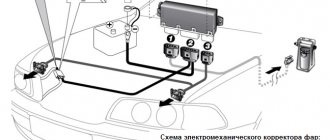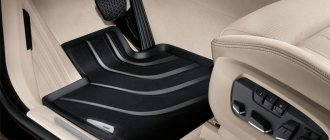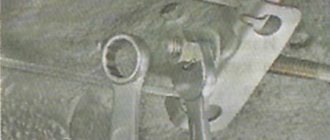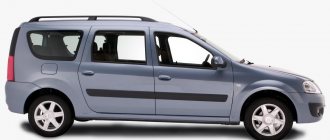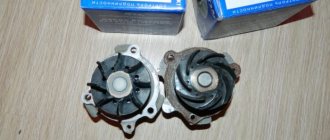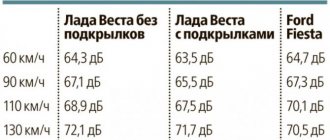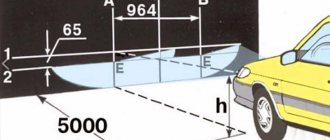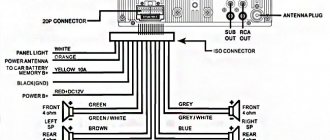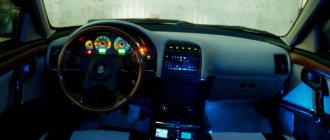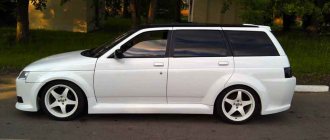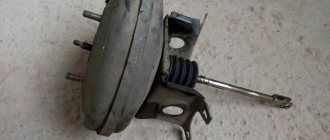Comfortable travel in a car is one of the main priorities for passengers and the driver. However, few domestic car manufacturers pay due attention to acoustic comfort. The Lada Granta line of cars also has this problem, so the owners of this car sooner or later resort to this type of additional tuning such as sound insulation.
Soundproofing a car is one of the main stages when tuning a Lada Granta, which is quite possible to do with your own hands, and besides, such work turns out to be of much higher quality, unlike the work of a specialized service.
Materials for car sound insulation
Shumka consists of several components, each of which must be made of a specific material.
Vibration isolation
Extraneous sounds appear due to vibrations, the frequency of which is 20 Hz or more. To avoid such a hum, it is necessary to purchase vibration-isolating material, which is made on a rubber basis. It resembles liquid rubber and can be coated with a metallized coating on top. Vibration insulation dampens noise well, and it can be laid either in whole sheets or in strips at equal intervals. This material is sold in sheets measuring 0.5x0.7 m or 0.5x1.2 m. In stores you can find the following brands: Vibroplast, Bimast, Vibroplast, Isoplast, as well as less popular materials: STP SPLEN sound insulation and TEAC. Let's look at some of them:
- Self-adhesive sound insulation Vibroplast Silver with a metallized coating. It is flexible and is an easy-to-use material. Equipped with markings (5x5 cm squares), thanks to which you can easily cut sheets of the required size. Suitable for treating interior floors, doors, roofs, hoods and trunks. Does not require heating. Costs from 100 to 300 rubles.
- Bimast Bomb coated with aluminum foil. To work with the material, it must be heated to 40 - 50 degrees, which is not very convenient, but Bimast has the highest efficiency compared to analogues. Suitable for wheel arches, speakers, tunnel, driveshaft and area above muffler. Costs from 480 rubles.
Healthy! Most vibrations come from the engine compartment, floor and wheel arches. If you have car audio installed, then the doors near the speakers, the rear parcel shelf or the trunk lid may also make noise. The least amount of vibration can be heard from the pillars and roof of the car, so cheaper material can be used in these places.
The vibration material is applied first, followed by the sound insulation itself.
Noise insulation
A sound absorber is made of soft, porous materials designed to absorb sound waves coming from outside. Most often, drivers purchase material for car soundproofing from the following companies:
- Bitoplast 5. This material performs two functions at once - noise absorption and sealing, so you don’t have to buy additional anti-creak. Effectively eliminates rattles and squeaks in the car interior. This material is made from polyurethane foam with a protective anti-adhesive layer. In addition, Biplast retains its properties even at very low temperatures (down to -50 degrees). Costs about 360 rubles.
• installation of additional seals on Granta doors
Necessary tools: hair dryer; degreaser.
Closing the door, and in particular the “clap” itself, completely depends on the presence of a vertical seal, which, in turn, is installed only in the Luxury configuration, on the front and rear doors, as well as noise-resistant locks.
Vertical seals not only regulate the level of noise when closing the door, but also prevent noise from penetrating into the car interior.
Do-it-yourself soundproofing of a Lada Granta, even with a standard configuration, allows you to buy and install vertical door seals for yourself. All you need is to know the catalog numbers for the front door seals: 1118-6107028 and 1118-6107066. Catalog numbers for rear doors: 1118-6207028; 1118-6207029; 1118-6107066.
The installation process is quite simple and is carried out exclusively from top to bottom. It is worth noting the need for installation on a previously degreased surface.
The sealant must be glued at a temperature not lower than – 15 degrees, and the seal itself must be heated to 45 – 50 degrees, since it has an adhesive base.
Preparing for soundproofing
First of all, it is necessary to prepare the following tools (in addition to vibration and noise insulation and seal):
- a construction hair dryer (an ordinary household hair dryer will not work in this situation);
- stitching roller (with it you will glue the material to the surfaces of the car faster and better);
- scissors;
- stationery knife (for piercing bubbles);
- solvent or degreaser (they will need to treat the surface; regular White Spirit will do).
After this, dismantle all parts, clear the area and clean the surface of dirt and dust. The room temperature during operation should not be lower than +18+20 degrees. If all conditions are met, you can begin laying the Shumka.
Let's sum it up
In general, the insulation event allows you to take the LADA Granta to a new level in terms of comfort, as evidenced by multiple reviews from owners who carried out this action. Do not despair if the maximum insulation is not capable of 100% efficiency. Sometimes it is enough for car owners to have the doors soundproofed. In any case, driving in the car will become more enjoyable, which will be the best reward for the owner for his work.
General recommendations for working with materials
Vibration insulation is applied first. If it involves heat treatment, then warm it up with a hair dryer. When laying the vibra, it is not enough to simply apply it to the surface; you need to roll it well with a roller in all accessible places until the foil texture disappears. If the material is poorly pressed, then over time it will begin to peel off. Please note that the vibration will only have anti-corrosion properties if there are no bubbles underneath it, otherwise moisture will begin to accumulate in these places. Therefore, use a utility knife, carefully piercing them. At the joints, it is better to glue the vibration insulation end-to-end. The vibration does not have to be applied in whole pieces.
But it is better to apply Shumka in as large pieces as possible and under no circumstances cut it into strips, this will reduce the sound insulation effect to almost zero. In addition, individual small pieces will simply fall off over time. It is best to draw a kind of pattern on the roll of Shumka according to the dimensions of the surface to which you are going to glue it. After this, cut out the template and, slowly tearing off the protective film from it, begin sequentially gluing the material. So, step by step you can fix the sound insulation as evenly as possible. In this case, there should be no bubbles either, so go over the material well with a roller. If you do glue the sound insulation in pieces, then be sure to make sure that each part fits tightly to the adjacent one, without leaving any loopholes for noise.
There are no special subtleties when working with the seal; the main thing is to ensure that the material does not stick out at the ends of the parts.
Now let’s look at where sound insulation is most often installed.
What is the danger of noise?
I want to take a closer look at the topic of noise, since it is present in any car, and many owners believe that it is completely normal. However, in addition to simply unnecessary sound in the cabin, noise affects the following things:
- Noise has a depressing effect on the human auditory organs
- It reduces the driver's ability to reflexively act and clearly see the situation on the road
- Contributes to the occurrence of serious diseases, including mental ones, because it affects the nerves, creates stress, and causes irritation
- Blood vessels narrow due to constant noise, this activates the work of the heart, increases blood pressure and, over time, angina pectoris may appear.
- As you can see, constant noise is a very unsafe thing, especially for those who spend a lot of time driving, and the price is your health
Sound insulation of the hood
When soundproofing the hood lid, you should take into account its weight, since if you make this part too heavy, the shock absorbers will most likely soon leak. Therefore, it is better to use a light vibration for this area, for example, Vibroplast Silver. It is also worth considering that soundproofing the hood itself is not done in order to get rid of the noise made by the engine. In fact, this is necessary for its insulation. As insulation, you can choose Accent 10, which will retain heat and will not change its properties from high temperatures.
Important! There is no need to throw away the factory thermal insulation, since the new one cannot be a full replacement.
Some cars do not have a factory hood shroud, in which case use the thickest material possible.
Soundproofing Grants: do it yourself without the help of specialists
Soundproofing Grants yourself
Soundproofing Grants yourself is an operation that can be carried out without any problems. It is clear that noise is unnecessary and disturbing. It greatly irritates the driver on the road and does not allow him to relax. Soundproofing the Lada Grant yourself is also an opportunity to significantly increase the “capabilities” of the cabin in terms of acoustics. The sound will be completely different, and any acoustics will sparkle with different colors.
Extended noise insulation grant package
I would like to touch on the topic of noise in a car in a little more detail. In addition to being an unnecessary sound in a car, noise is characterized by the following things:
- It has a negative effect on some human organs;
- Noise reduces the driver's ability to see clearly and act reflexively;
- It contributes to the occurrence of all kinds of diseases, including mental ones, as it has a negative effect on the nerves;
- Due to constant noise, blood vessels narrow, the work of the heart muscle is activated, which causes blood pressure to increase and angina pectoris may occur;
- Noise is a source of stress.
Causes of noise
Sound insulation of Lada Granta car
As a rule, the noise varies:
- Intermittent. It occurs due to a faulty heater motor. Less commonly, the cause is the air conditioner or cooling motor;
- Permanent. In this case, we are talking more about external noise entering the cabin from outside. Often the cause of constant noise is the transmission, suspension or bad tires;
- Impulse. In this case, such noises are associated with creaks, knocking or clicks. Car body panels, various interior elements, and much more can also create impulse noise.
Distribution methods
It will also be useful to know about the types of noise progression:
- The airborne method of propagation involves the transmission of noise from the source to a specific point (the ears of the driver or passengers). The volume of the sound in this case will be determined by the presence of obstacles in its path: the more there are, the weaker the noise will be;
- There is also a structural method of progression of noise. It involves the transmission of sound by various body parts that create vibrations. It will be useful to know that vibration is transmitted better through metal than through plastic or similar material.
Note. It is because of this that two options for dealing with noise are used. ZPM (sound-absorbing materials) eliminate noise transmitted by air, vibration-absorbing materials reduce vibrations.
Soundproofing doors
When processing doors, it is also worth considering the weight of the materials; if they are too heavy, you risk breaking the hinges. Therefore, it is important to understand why you need sound insulation in these areas. If you want to improve the sound, then you can’t do without a little expense and will have to glue at least 4 layers of Shumka. For more “modest” requests, only a vibration applied to the inside of the door opposite the speakers will be sufficient. It is also worth noting that the thinner the metal, the more material you will need.
Do-it-yourself surgery technique
As you know, sound insulation on Grant is carried out in stages. First one part of the car is processed, then the others.
Doors
How to properly soundproof Granta doors
As a rule, the soundproofing process begins with the doors. Some, after completing the “noise” of the doors, stop there and do not continue, others carry out complete sound insulation. If you treat only the doors, this will be called partial sound insulation, but it gives a good result, especially in terms of improving acoustic properties.
Options for “shumming” doors, in turn, can also be different:
- The minimum option, when only the outer panel and door card are processed with materials;
- Standard version, which will be described in detail below;
- The maximum version of execution, which is of more competitive interest. More dense and thick materials are used here.
Technology for soundproofing doors Grants according to the “Standard” version
Here's what to consider:
- First we need to provide access to the surfaces that we will soundproof;
- Then you need to prepare these same surfaces for applying sound insulation materials, which means cleaning and degreasing them.
Processing begins with the door panel:
- First, it is covered with “vibro”;
- Then a sound absorber is placed on top, which simultaneously serves as a heat insulator.
The next process involves processing the door frame:
- The frame can be processed with or without sealing the holes. The first method looks more preferable, but it is not always possible to implement and it is not always suitable;
- It is advisable to cover the holes with material from the Viek kit. It must be cut to the size and shape of the windows and pasted over (the material consists of aluminum foil and an adhesive base).
It will also be useful to know that it is necessary to ensure the functionality of the rods and cables located inside the door.
Doors and their sound insulation
Next we move on to the “vibro” pasting:
- You can use either “Vibroplast M1” or “Bimast”;
- We make sure that we get a surface consisting of 2 solid sheets of metal, between which a vibration-absorbing layer is installed.
Go ahead:
- Now we need to process the door trim;
- It is advisable to seal the joints of its parts with sealant or some kind of hot-melt adhesive;
- In some areas, such as pockets and other flat surfaces, it is recommended to install Vibroplast M1;
- We cover the entire surface of the casing from the inside with “Bitoplast 5” or other cushioning material.
Processing of other parts of Grants
Here's what you need to know:
- The side parts of the Lada Granta car body are processed in a similar way;
- The floor is treated with hard materials, not soft ones. The heavy Bimast looks more preferable;
- As with the processing of doors, the “noise” of other parts of the car can imply three options. And the standard option looks more preferable;
- It is advisable to cover the engine compartment partitions and wheel arches with “Barrier” type material. Conventional “vibrations” in these parts of the car may not provide the desired effect of eliminating noise;
- The Granta's ceiling, as a rule, has a larger area than the rest of the car. The metal in this area is thinner. For this reason, it is recommended to glue “Visomat PB” here.
- After the “vibro” layer, “Spleen” is glued to the ceiling;
- The “noise” of the luggage compartment and engine compartment completes the soundproofing procedure for the Lada Granta.
How to improve sound insulation in the Lada Granta
Video review and photos - materials will only help consolidate the information. When working with your own hands, it is recommended to look at the instructions more often. As a rule, the price of materials for the “Shumka” Grants is not so high, which allows you to save a lot of money.
Noise insulation of wheel arches and trunk
The niche for the spare wheel should be completely covered with vibration, the same applies to the plastic lining of the trunk.
Do-it-yourself noise insulation of wheel arches will save you from road noise, especially in winter when studs are used. To process the wheel arches, you must first remove the standard plastic wheel arch liners (but do not throw them away), clean the parts from dirt and dust and treat the free surface with a vibration isolator. The fender liners themselves can also be covered with material.
Attention! The video contains elements of profanity.
Comparison of treatment zones
There are zones that can be processed independently of the others:
- doors;
- wheel arches;
- trunk;
- salon floor;
- front panel;
- ceiling.
The treatment of Lada Granta doors and wheel arches provides the most noticeable effect. After finishing, doors become heavier, close more clearly and with a more noble sound. Sound insulation of doors cuts off street sounds, road debris reaching the outer surface can no longer be heard, and acoustics begin to sound differently. The wheel arch treatment combats the sound of tires rolling.
The intensity of the sound from pebbles flying along the arches and streams of water from under the wheels is reduced. When installing a powerful audio system, ceiling insulation becomes important. Without connection to quality music, the ceiling is not an important area. Soundproofing materials only show themselves here when it rains. In the trunk area, it is necessary to suppress the noise of the exhaust system. This area becomes especially important when installing powerful speakers in the luggage rack and a subwoofer in the trunk.
Soundproofing the cabin floor muffles engine and transmission noise. These sounds largely reach the vehicle's interior by being reflected from the road surface. In the front panel you have to fight with “crickets”. In general, this is limited to pasting sealant on the joints of parts, rods, wiring and pulling all fasteners.
Even the most complete sound insulation rarely gives a 100 percent result. Difficult-to-eradicate “crickets” become especially noticeable against the backdrop of a general reduction in noise. You need to be prepared for this when deciding on such long and painstaking work.
Soundproofing of the floor
In addition to the wheels, while driving on the road, the floor of the car also makes noise, and pebbles knocking on the bottom bring a lot of unpleasant sensations. For this area it is better to use the highest quality materials, for example, Bimast Bomb (although this is a heavy vibration, its characteristics are the best). A layer of Shumka 4-8 mm thick is applied on top.
Make sure that there are no joints between the sheets of materials, and try to cover as large an area as possible, preferably with one sheet. The same applies to soundproofing the car floor.
After applying all the components, leave the car for 12 hours so that all the adhesive bases “set” well.
• sound insulation of the Lada Granta glove box
Tools needed: scissors; roulette; glue “Moment”; cardboard.
Granta's glove compartment is made of rough plastic, which, when in contact with any objects, creates rather unpleasant sounds. In order to avoid such contact, as well as generally increase the degree of noise insulation of the car, it is necessary to soundproof the glove box.
This process is accompanied by the use of modelin; you can also use other materials with an adhesive side, for example, bitoplast or splen. If all these materials are not available or you simply don’t like it, you can use carpet.
It is worth noting that the carpet does not have an adhesive base and is attached with glue, which was indicated above in the list of tools. Soundproofing of the glove compartment can be done both from the outside and from the inside.
Where is the noise coming from?
First, let's determine the main places through which noise enters the cabin. These include:
- hood;
- doors;
- bottom;
- partition between the engine compartment and the passenger compartment;
- interior roof;
- luggage compartment.
It is these elements that are subject to processing.
Do-it-yourself car soundproofing, what materials are required
There are three types of materials used in the process of car noise reduction:
- vibration-absorbing;
- sound-absorbing;
- gaskets
To achieve maximum effect, it is recommended to use all these materials in combination.
What is the danger of noise?
The basic configuration of the Lada Granta car has everything you need, but the level of comfort of the vehicle is average. Unnecessary sounds can be removed only through comprehensive sound insulation. It will give the following results:
- will reduce the negative impact of noise on some organs;
- will allow the driver to clearly react to situations on the roads and quickly take the necessary actions;
- will protect against the development of dangerous diseases, including mental ones (high noise levels negatively affect the nervous system).
For example, a large number of unpleasant sounds leads to a narrowing of the lumen of blood vessels, activates the work of the heart muscle, causes a sharp jump in blood pressure, angina pectoris. Therefore, noise becomes a source of chronic stress.
Vibration-absorbing materials (vibration dampers)
The vibration absorption process is based on the internal friction that occurs in the material. For the most part, such materials are made on the basis of butyl mastic or bitumen, which have a high degree of mechanical loss. There are also so-called bimasts, consisting of two layers: bitumen and mastic.
On one side, vibration absorbers have an adhesive layer, which greatly simplifies installation, and on the other, a protective coating in the form of fabric, thick paper or aluminum foil. Let's consider the most popular materials.
1. Bimast is a relatively new two-layer material (mastic and bitumen). It has 3 varieties: “Standard” (3 mm thick) with a fabric coating, “Super” (4 mm) with a thick paper coating, and “Bomb” (4 mm) with an aluminum coating.
2. Vibroplast is a plastic material based on a polymer adhesive composition coated in the form of durable aluminum foil. Until recently, the material was offered for sale in two varieties: M1 (thickness 1.5 mm) and M2 (thickness 2.3 mm), but not so long ago Vibroplast “Silver” (2 mm) and “Gold” (2 mm) appeared on sale .3 mm). This modern material differs from M1 and M2 in that, with the same thickness, it has a higher mechanical loss coefficient: 0.25 and 0.33, respectively.
3.Vizomat – self-adhesive vibration-absorbing material based on bitumen. It is available for sale in two types: PB (without coating, thickness 2 and 3.5 mm) and MP (with aluminum coating, thickness 2.7 mm).
Sound-absorbing materials
Sound-absorbing materials are used to protect the interior from outside noise. They are usually applied as a second layer to the vibration absorber. They also have an adhesive mounting layer. The most popular sound absorbers are:
Splen is a lightweight material based on finely porous polyethylene foam. It does not absorb moisture and is resistant to temperature changes;
The barrier is a similar material made of polyethylene;
Vibroton is a sound insulator based on polyethylene with a bitumen layer.
Padding materials
Gasket materials are designed to eliminate friction between the plastic elements of the interior. Most often they are used to silence parts of the dashboard and door cards.
These include:
Bitoplast is an elastic polyurethane 5-20 mm thick, impregnated with a special waterproof solution, and equipped with an adhesive mounting layer;
Madeleine is a decorative fabric-based material with a thickness of 1-1.5 mm.
Calculation of the quantity of materials
It is not difficult to calculate the required amount of materials for soundproofing a car, but this will require disassembling the interior, trunk, and measuring everything with a tape measure. We offer an easier way. Below is a table with calculations of materials already carried out for different classes of machines. These are, of course, inaccurate indicators, but they are sufficient to understand how much of something will be needed and how much it will cost.
| Car class | Bottom | Trunk | Doors (4 pcs) | Roof | Hood |
| A | B – 3 ZV – 3 | B – 2 ZV – 2 | V – 2.4ZV – 1.5P – 1.5 | B – 3 ZV – 3 | ZV – 2 |
| B | B – 3 ZV – 3 | B – 2 ZV – 2 | V – 2.4 ZV – 1.5 P – 1.5 | B – 3 ZV – 3 | ZV – 2 |
| C | B – 4 ZV – 4 | V – 2.8 V – 2.8 | V – 2.4 ZV – 1.5 P – 1.5 | B – 4 ZV – 4 | ZV – 2 |
| D | B – 4 ZV – 4 | B – 3 ZV – 3 | V – 2.4 ZV – 1.5 P – 1.5 | B – 4 ZV – 4 | ZV – 2 |
| E | B – 4 ZV – 4 | B – 3 ZV – 3 | V – 2.4 ZV – 1.5 P – 1.5 | B – 4 ZV – 4 | ZV – 2 |
| Crossovers | B – 4 ZV – 4 | B – 3 ZV – 3 | V – 2.4 ZV – 1.5 P – 1.5 | B – 4 ZV – 4 | ZV – 2 |
B – vibration-absorbing material;
ZV – sound-absorbing material;
P – cushioning material.
The numbers indicate the amount of material in m2.
If you need to silence the instrument panel, add an extra meter and a half of cushioning material.
Algorithm for carrying out noise insulation work
First of all, Granta Liftback doors are soundproofed. This is explained by the fact that the main cause of noise lies precisely in them. Even if this work does not bring results and you have to continue installing the Shumka further, the cabin will become much quieter.
Before gluing, the sound insulation should be heated with a hairdryer, applied to the area to be glued and smoothed with a roller or other method. This will allow the material to take shape, literally merge with the surface being treated, repeating all its curves, which will improve noise absorption.
Conclusion Installing sound insulation yourself is not such a difficult job. Why overpay? Hone your skills on your car, maybe this will become your additional income in the future? There are a lot of people willing!
What else is needed for soundproofing?
In addition to materials, you will need a warm box or garage (in the summer, work can be done outside under a canopy). When carrying out work, the ambient temperature should not be lower than 18 0 C. Otherwise, the material will not adhere well to the surface.
You also need to make sure that you have the necessary tools and resources at hand:
- work gloves;
- White Spirit;
- several sheets of cardboard;
- industrial dryer;
- knife;
- rags;
- construction tape (ruler);
- a small hard roller or soft spatula;
- pencil or marker.
Tools and materials list
Before you carry out soundproofing yourself, you need to disassemble the interior of the car. In order to disassemble the interior of the Lada Grant with sufficient efficiency and safety of the panels, you can make do with publicly available tools (keys). However, we recommend stocking up on some specific products.
- plastic grips and shovels that allow you to painlessly disassemble the interior components of the car;
- a narrow roller made of plastic or hard rubber;
- special set of screwdrivers and gloves.
Self-adhesive materials available for sale today allow you to do without a hairdryer. Before directly gluing the panels, the sheets for vibration insulation should be laid out in the sun for a while, which will give them sufficient elasticity.
In addition, we stock up on the following materials:
- rags and sponges;
- sheets for noise and vibration insulation;
- solvent;
- plastic clamps and gaskets;
- soundproofing mastic.
White spirit can act as a solvent, because it is not as toxic as its analogues.
Sound insulation of the hood
It's better to start work from the hood. This is the easiest area where you can practice cutting and gluing special materials. Inexpensive vibration and sound absorbers can be used for the hood. Vibroplast M1 is perfect for the first, and Splen for the second.
1. Raise the hood and inspect it from the inside. If there is thermal insulation there, carefully remove it. The inner surface of the hood lid is not uniform. It has symmetrically located recesses. In fact, they need to be insulated.
2. Treat the surface with white spirit and wipe dry with a rag. We measure, mark and make patterns from cardboard that correspond to the shapes and sizes of the recesses.
3. We transfer them to vibration-absorbing material. Cut it out.
4. Heat the cut out part with a hair dryer to make it more elastic.
5. Having removed the protective film on the adhesive layer, glue the vibration absorber to the selected area. After this, we warm it up again with a hairdryer and press it to the surface with maximum force, using a roller or spatula;
6. When all the recesses are glued, we cut out and glue the sound-absorbing material – Splen – in the same way.
7. We install the insulation back.
Tools for disassembling the interior
- Basic set for the motorist. Sometimes such kits can be purchased as additional interior equipment for an additional payment when purchasing a car. This kit includes everything you need to disassemble the interior yourself.
- Vehicle Operation Manual. The diagrams presented in the manual will greatly simplify the disassembly process, and from there you can find out which tools to use for certain parts of the machine.
- A device that allows you to remove plastic clips. Many interiors are attached to each other with plastic connecting elements. Of course, you can use a regular screwdriver to dismantle them, but it can damage or deform the plastic parts.
Soundproofing doors
This process is somewhat more complicated, since the doors have a more complex structure than the hood cover. In addition, good sound insulation in the doors is also needed in order to ensure high-quality sound from the front speakers of the acoustic system.
Here you also cannot overdo it with materials, since excess weight will subsequently lead to warping of the door hinges. It is better to use a thin but high-quality vibration damper. Vibroplast “Silver” with a thickness of 2 mm will cope with this task perfectly. As for the sound absorber, you can use the same Splen or Barrier with a thickness of 4-5 mm.
1. Dismantle the door cards. The vibroplast is placed through the door openings onto its entire surface. If it has traces of anti-corrosion material, remove them with white spirit.
2. We measure and cut out the appropriate piece of Vibroplast. We warm it up with a hairdryer, remove the film, and stick it on the inner wall of the door. This process is quite inconvenient, but you need to try to smooth and press the material onto the iron.
3.The next step is laying the sound absorber. Having made a pattern from Spleen, we glue it on top of the vibroplast.
4.After this, we cover the entire door with Spleen, closing the technological holes.
5. Let's move on to the door cards. We cover them from the inside with 10 mm bitoplast. In addition, rods, lock levers and other moving (potentially knocking and creaking) metal parts of doors are covered with Madeline.
6. We carry out this procedure with all doors.
How to apply it correctly?
To remove the interior panels, unscrew all the existing screws. We pry off a specific element from one side, gradually moving to cover the entire perimeter. This manipulation allows the plastic clips and metal clips of the panel to snap off painlessly.
Removal of load-bearing components of the interior (seats, belts, etc.) is carried out using keys of the appropriate size.
The internal section of the Lada Granta body that is “freed” from the decorative panel is thoroughly cleaned of any existing contaminants while simultaneously removing the anti-corrosion layer. Then the surface is degreased. And only after this, sound insulation is carried out with your own hands.
Some Lada Granta owners mistakenly try to cover the entire area of the interior panels of the cabin, which is a waste of time and expensive insulating material. Only extended areas of flat surfaces that are easily susceptible to the resonance effect should be pasted. As a result, the pasted area occupies about 70% of the entire surface.
We warn you when doing noise insulation with your own hands that it is inadmissible to seal the technological and ventilation openings, because they serve to ensure normal air circulation and remove moisture. Also leave the plugs intact, which are periodically removed to carry out preventive manipulations with the technological lines of different systems.
Sound insulation of the underbody and partition of the engine compartment
This stage of work is the most labor- and time-consuming. For the bottom, use the thickest and heaviest vibration damper. The ideal option here would be 4 mm Bimast “Bomb”. For the partition it is better to use Vibroplast “Silver” or “Gold”. Spleen (4-6 mm) is suitable as a soundproofing material.
1. We disassemble and dismantle the instrument panel, seats, carpet. If the bottom is treated with anti-corrosion from the inside, remove it with white spirit.
2. We measure and cut out the largest pieces of Bimast. We warm them up with a hairdryer and lay them on the floor, trying not to miss a centimeter. If there are clearings left during the laying process, we seal them on top with pieces of Bimast, overlapping the edges by at least 30 mm. Particular attention should be paid to the inner curves of the wheel arches.
3. Warm up the already laid coating with a hairdryer and press it with a roller or spatula.
4.In the same way we glue the partition of the engine compartment on the passenger compartment side with Vibroplast.
5.Measure and cut out the Splen. We glue it on top of the vibration absorber.
6. We install the dashboard and interior.
7.If necessary, when assembling the instrument panel, you can glue individual elements with Madelin.
What's the result?
- If all the work was done correctly, then soundproofing the engine shield can significantly reduce the noise level in the vehicle interior. In medium load modes, noise from the engine and transmission (provided that the units are in full working order) practically does not penetrate into the “capsule” of the interior space.
- At the same time, the level of vibrations from the engine is reduced, the vibrations are transmitted less strongly to the steering wheel, they are less reflected on the steering wheel when driving over bumps, etc. The engine shield itself acquires additional rigidity, and creaks in the dashboard area and along the contour of the windshield disappear.
- The main disadvantage of this operation is rightly considered to be the removal of the instrument panel. In some cases, there is a significant risk of damaging expensive elements of electrical equipment, breaking latches, and ruining the appearance of plastic and other inserts.
- Also, a number of problems may arise during or after reassembly. It is not uncommon that after the process of soundproofing the engine shield, malfunctions or failures in the operation of the climate control, audio system, on-board computer and other devices are observed. The reason is errors during assembly and damage.
The material is a non-flammable fabric that is resistant to oil, fuel and technical fluids. There is also a heat-resistant adhesive layer. In summer, the material can be secured to the hood with pistons (based on the principle of factory sound insulation). In winter, stp heatshield is placed on the engine, performing the function of a car blanket. This additional protection will further isolate engine noise, increasing acoustic comfort.
Insulation of the engine compartment. How and how to properly insulate a car’s engine and hood before winter: materials for insulation. Tips and tricks.
What is a car blanket for an engine: when is it needed and the main features. How to make a car blanket yourself, selection of materials, production. Useful tips.
The engine warms up slowly at idle or while driving: why does this happen? Possible malfunctions of the cooling system, other reasons.
Features of choosing a car blanket for an engine. Materials for making engine insulation: felt or synthetic. Basic properties and parameters, other criteria.
Why does the engine overheat? What should the driver expect and what damage may occur if the engine overheats. What to do if the internal combustion engine overheats.
The engine temperature does not rise, the internal combustion engine temperature needle drops while driving. Why does the temperature drop after turning on the stove? Diagnostics and repair, advice.
Sound insulation of the engine shield on the engine side
Sound insulation of a car engine compartment is the most specific work, which depends on the design of the car, and is not solved only by the choice of materials for vibration insulation and noise absorption
It is important to immediately make a significant reservation if you need a tangible result, and not its beautiful appearance. Unfortunately, many car owners (especially diesel ones) do not understand simple truths - you need to start soundproofing by checking the condition of the engine, then the suspension and body parts, you need to repair the car, which itself makes less noise in good technical condition, without which, Soundproofing the engine bulkhead will not give the desired effect
Roof sound insulation
To soundproof a roof, it is better to use a thin vibration damper such as Vibroplast M1 or “Silver”. There is absolutely no need for excess weight here. For sound absorption, Spleen with a thickness of 4 mm is ideal, which is also a good heat insulator.
The processing procedure is similar.
2.Remove the factory sound insulation.
3. Degrease the surface with white spirit.
4.Mark, cut, warm up the vibroplast.
5.Glue it between the stiffening ribs and press it.
6. Apply a sound absorber as the second layer.
